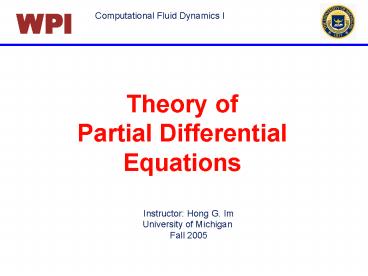Direct Numerical Simulations of Multiphase Flows PowerPoint PPT Presentation
1 / 39
Title: Direct Numerical Simulations of Multiphase Flows
1
Theory of Partial Differential Equations
Instructor Hong G. Im University of Michigan
Fall 2005
2
Outline
- Basic Properties of PDE
- Quasi-linear First Order Equations
- - Characteristics
- - Linear and Nonlinear Advection Equations
- Quasi-linear Second Order Equations
- - Classification hyperbolic, parabolic, elliptic
- - Domain of Dependence/Influence
- - Ill-posed Problems
3
Definitions
- The order of PDE is determined by the highest
derivatives. - Linear if no powers or products of the unknown
functions or its partial derivatives are present. - Quasi-linear if it is true for the partial
derivatives of highest order.
4
Definitions
- The general solution of PDE are arbitrary
functions of specific functions.
5
Quasi-linear first order partial differential
equations
6
Consider the quasi-linear first order equation
where the coefficients are functions of x,y, and
f, but not the derivatives of f
7
The solution of this equations defines a single
valued surface f(x,y) in three-dimensional space
f
y
ff(x,y)
x
8
An arbitrary change in f is given by
f
f
df
dy
dx
y
ff(x,y)
x
9
The original equation and the conditions for a
small change can be rewritten as
10
Since
Implying that (a,b,c) is tangent to the surface
ff(x,y). Picking the displacement in the
direction of (a,b,c)
Separating the components
Characteristics
11
The three equations
Given the initial conditions
the equations can be integrated in time
12
y
x
13
Consider the linear advection equation
The characteristics are given by
or
Which shows that the solution moves along
straight characteristics without changing its
value
14
Graphically
Notice that these results are specific for
15
Add a source
The characteristics are given by
or
t
f
Moving wave with decaying amplitude
x
16
Consider a nonlinear (quasi-linear) advection
equation
The characteristics are given by
or
The slope of the characteristics depends on the
value of f(x,t).
17
t
Multi-valued solution
t3
t2
t1
f
x
18
Why unphysical solutions?
- Because mathematical equation neglects some
physical process (dissipation)
Burgers Equation
Additional condition is required to pick out the
physically Relevant solution
Correct solution is expected from Burgers
equation with
Entropy Condition (to be continued)
19
Quasi-linear second order partial differential
equations
20
Consider a general quasi-linear PDE
where
21
Starting with
Define
PDE becomes
with
22
In matrix form
Are there lines in the x-y plane, along which the
solution is determined by an ordinary
differential equation?
23
Is this ever equal to
24
(No Transcript)
25
Solution determined by ODE (Characteristics
exist) only if
Or, in matrix form
Compatibility Relation
26
The determinant is
Solving for ?
27
Two real characteristics
One real characteristics
No real characteristics
28
Examples
Wave Equation
Comparing with the standard form
shows that
Hyperbolic
29
Examples
Laplace Equation
Comparing with the standard form
shows that
Elliptic
30
Examples
Heat Equation
Comparing with the standard form
shows that
Parabolic
31
Examples
Wave equation
Hyperbolic
Parabolic
Heat equation
Elliptic
Laplace equation
32
Hyperbolic
Parabolic
Elliptic
33
Wave equation
First write the equation as a system of first
order equations
Introduce
yielding
from the PDE
since
34
Two characteristic lines
t
P
x
35
Ill-posed problems
36
Ill-posed Problems
Consider the initial value problem
This is simply Laplaces equation
which has a solution if ?f/?x or f are given on
the boundaries
37
Ill-posed Problems
Here, however, this equation appeared as an
initial value problem, where the only boundary
conditions available are at t 0. Since this is
a second order equation we will need two
conditions, we may assume are that f and ?f/?x
are specified at t 0.
Consider separation of variables
PDE becomes
38
Ill-posed Problems
General solution
determined by initial conditions
Therefore,
as
Ill-posed Problem
39
Ill-posed Problems Summary

